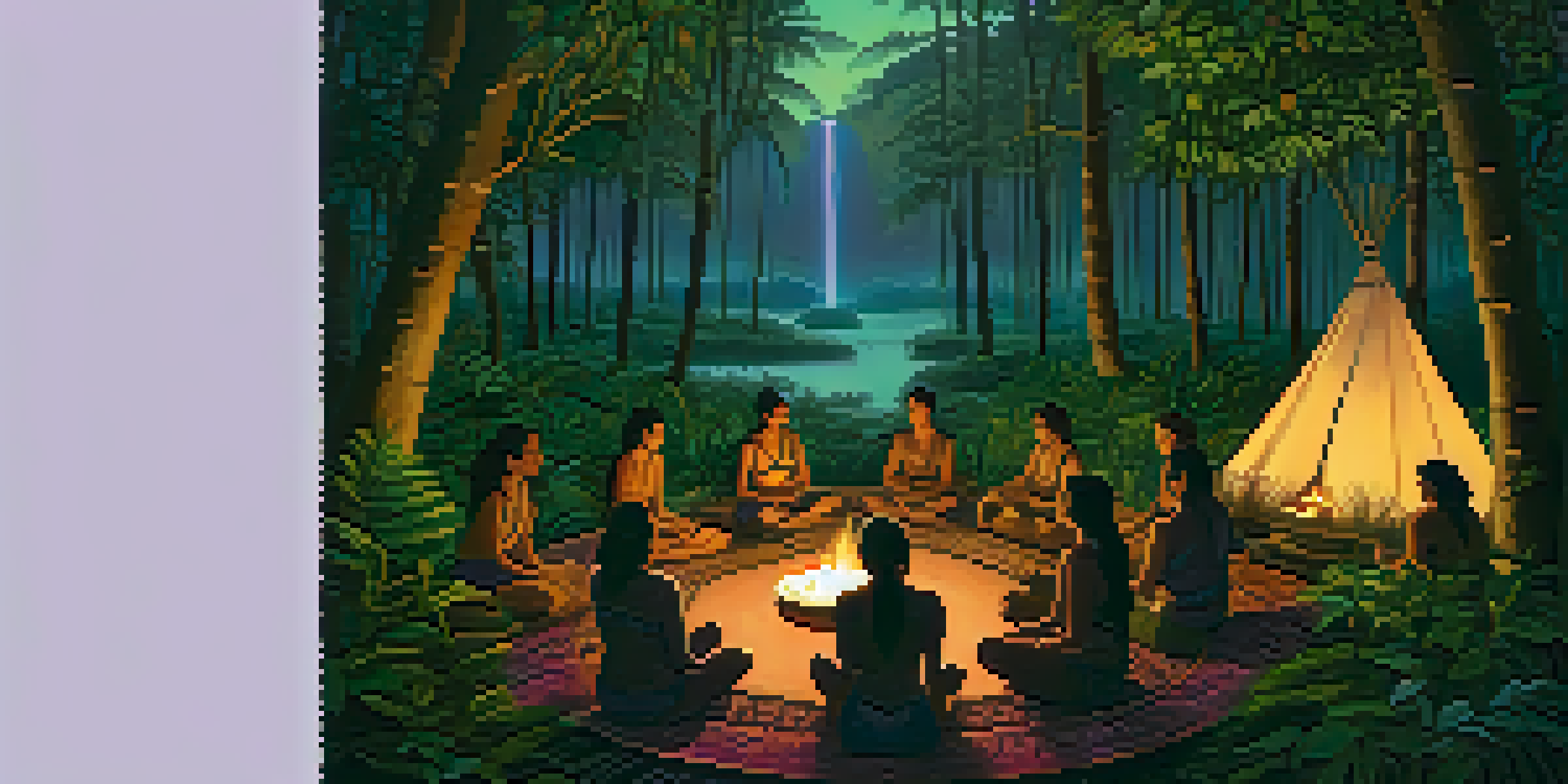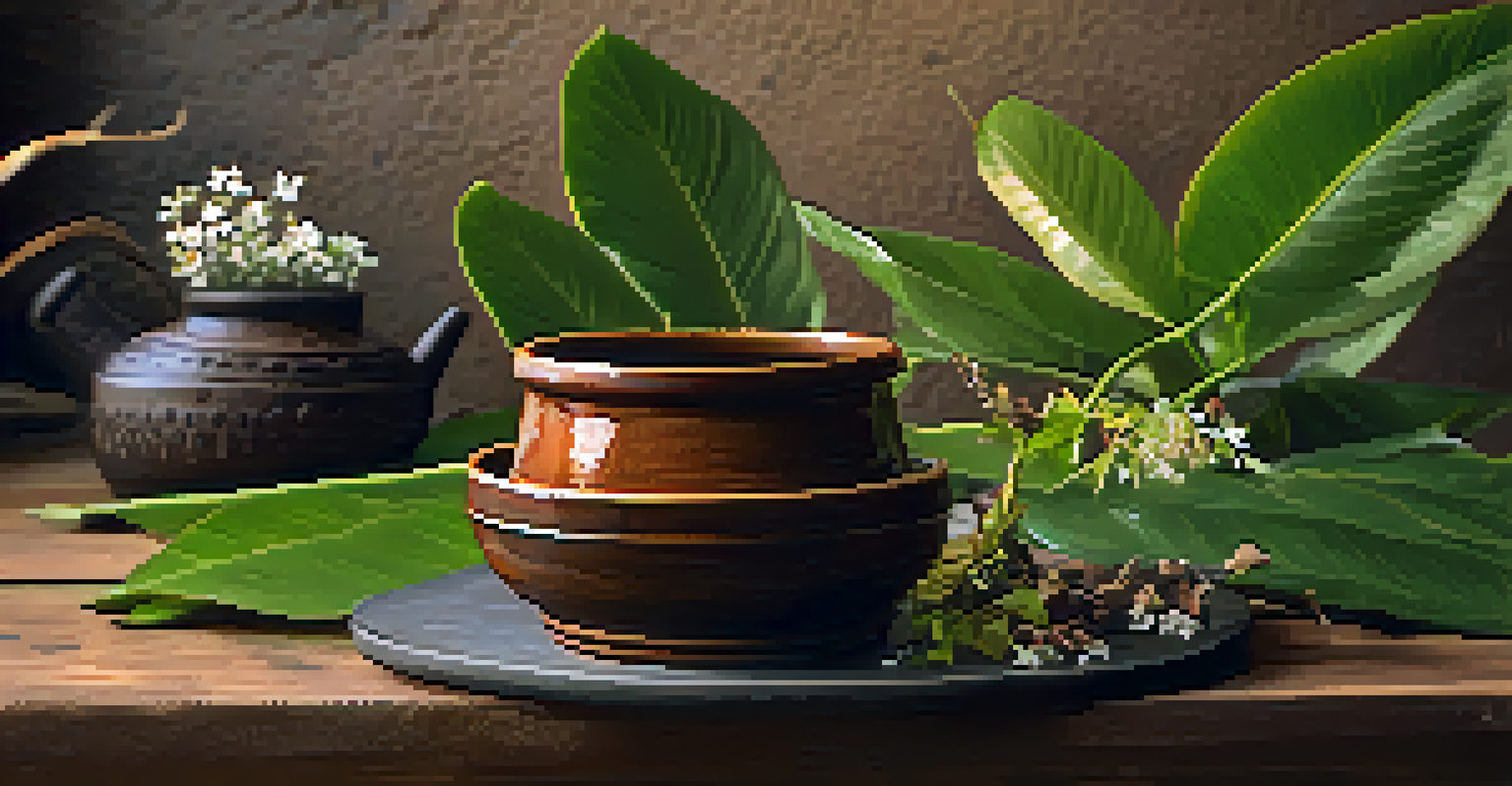Ayahuasca Journeys: Pathways to Greater Mental Resilience

Understanding Ayahuasca and Its Cultural Significance
Ayahuasca is a powerful plant medicine originating from the Amazon rainforest, traditionally used by indigenous tribes for spiritual healing and insight. The brew, made from the Banisteriopsis caapi vine and other plants, is revered for its psychoactive properties. In recent years, it has gained popularity beyond its cultural roots, attracting individuals seeking deeper self-understanding and emotional healing.
The wound is the place where the Light enters you.
The ceremonies often take place in a communal setting, guided by experienced shamans who facilitate the experience. This collective aspect fosters a sense of belonging and shared purpose, enhancing the journey's therapeutic potential. By understanding its cultural significance, participants can approach their experiences with respect and openness, setting the stage for greater mental resilience.
Ultimately, engaging with Ayahuasca is about more than just the individual; it's a journey that connects you to a larger narrative of healing, tradition, and community. This shared experience can help build mental resilience, as participants learn from one another and support each other through challenging moments.
The Science Behind Ayahuasca and Mental Health
Research on Ayahuasca has revealed promising insights into its effects on mental health. Compounds in the brew, particularly DMT (dimethyltryptamine), can promote neuroplasticity, which is the brain's ability to adapt and change. This adaptability is crucial for developing mental resilience, as it allows individuals to rewire negative thought patterns and emotional responses.

Moreover, studies suggest that Ayahuasca can be effective in treating conditions such as depression and anxiety. Participants often report experiencing profound emotional releases and gaining new perspectives on their challenges. These breakthroughs can lead to lasting changes in behavior and mindset, which are essential components of mental resilience.
Ayahuasca's Healing Community
Ayahuasca ceremonies foster a sense of community, enhancing the healing journey through shared experiences and support.
As we delve deeper into the scientific aspects, it becomes clear that Ayahuasca is more than a mystical experience; it has tangible benefits that can empower individuals to face life's adversities with greater strength and clarity.
Preparing for an Ayahuasca Journey
Preparation is key to having a meaningful Ayahuasca experience. This often involves physical and mental detoxification, which means embracing a clean diet and avoiding certain substances ahead of time. By nourishing your body and mind, you create an optimal environment for the Ayahuasca to work its magic.
What we think, we become.
Additionally, setting intentions for your journey can enhance the experience. Think about what you hope to learn or release during the ceremony. This clarity allows the medicine to guide you more effectively, helping you uncover deeper insights that contribute to mental resilience.
Lastly, mental preparation is equally important. Engaging in practices like meditation or journaling can help center your thoughts and emotions. By arriving grounded and open, you're more likely to navigate the journey's challenges and emerge with newfound strength.
What to Expect During the Ceremony
During an Ayahuasca ceremony, participants typically gather in a safe, serene environment, often under the guidance of a shaman. As the brew is consumed, effects begin to surface, often leading to profound emotional experiences, visions, or even physical purging. This process can feel overwhelming, but it’s an integral part of the healing journey.
Many report encountering deep-seated fears or unresolved trauma during their experience. While this can be daunting, it’s important to remember that confronting these feelings is a vital step toward healing. Just as a caterpillar must struggle to emerge from its cocoon, embracing discomfort can lead to personal growth and greater resilience.
Science of Mental Resilience
Research indicates that Ayahuasca promotes neuroplasticity, enabling individuals to rewire negative thought patterns and improve mental resilience.
Throughout the ceremony, the supportive atmosphere created by the shaman and fellow participants plays a crucial role. This sense of community can provide comfort, reminding individuals that they are not alone in their struggles and that healing is possible.
Integration: Making Sense of the Experience
After the ceremony, participants often feel a mix of emotions—elation, confusion, and sometimes sadness. This is where the integration process comes into play, helping individuals make sense of their experiences. Integration involves reflecting on the insights gained and finding ways to apply them in everyday life.
Sharing your journey with trusted friends or therapists can facilitate a deeper understanding of what you've experienced. Journaling is another powerful tool that allows for introspection and clarity. By articulating thoughts and feelings, you create a roadmap for personal growth and resilience.
Ultimately, integration is about taking the lessons learned during the Ayahuasca journey and weaving them into your daily life. This empowers individuals to face challenges head-on, armed with new perspectives and strength.
Potential Challenges and Emotional Release
While many experience profound healing through Ayahuasca, it's essential to acknowledge that the journey can be challenging. Emotional releases, often manifested as tears or intense feelings, are common. This cathartic process is a way for the body to purge negativity and past traumas, ultimately leading to healing.
However, confronting these emotions can be difficult and sometimes disorienting. Participants may feel like they are reliving painful memories or facing fears head-on. It's crucial to approach these moments with compassion, reminding oneself that this discomfort is part of the journey toward resilience.
Integration for Lasting Change
The integration process post-ceremony is crucial for applying insights gained during Ayahuasca experiences to everyday life.
Support from the shaman and fellow participants can make a significant difference during these challenging moments. The communal aspect of the ceremony fosters a safety net, allowing individuals to navigate their emotions with courage and ultimately emerge stronger.
Building Lasting Resilience Beyond Ayahuasca
As participants integrate their Ayahuasca experiences, the real work begins: building lasting resilience in daily life. This often involves incorporating practices such as mindfulness, yoga, or therapy to maintain the insights gained during the ceremony. By making these practices a part of your routine, you cultivate a foundation for emotional stability.
Additionally, surrounding yourself with supportive communities can enhance resilience. Engaging with others who share similar journeys fosters a sense of accountability and encouragement. It's a reminder that personal growth is a continuous process, and you're not alone on this path.

Ultimately, the lessons learned through Ayahuasca can serve as a catalyst for lifelong resilience. By embracing challenges and nurturing emotional well-being, individuals can lead more fulfilling lives, equipped to handle whatever comes their way.